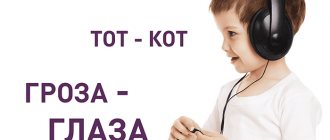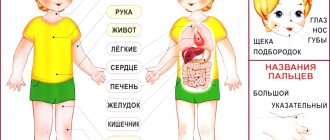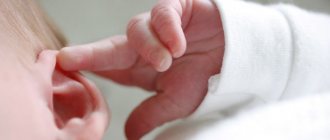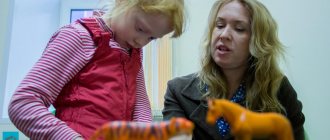Games and exercises for the development of auditory perception in preschool children
Games and exercises for the development of auditory perception in preschool children - methodological recommendations for parents and educators.
This manual is intended for classes on the development of non-speech hearing in children of early preschool age.
The child must learn to hear the sounds of the environment, including the voices of animals, the sound of musical instruments, etc. There is an accumulation of new auditory images of non-speech sounds, which subsequently makes it possible to quickly differentiate sounds into two important categories: “speech” and “non-speech”.
The games and exercises recommended in the manual contribute to the development of auditory perception and auditory memory. The ability to recognize the sounds of the environment will allow the child to master speech more quickly in the future.
The development of auditory perception occurs in two directions: on the one hand, the perception of surrounding sounds develops (physical hearing), on the other, the perception of the sounds of human speech (phonemic hearing).
Non-speech (physical) hearing is the auditory capture and differentiation of various sounds of the surrounding world (sounds of nature, traffic noise, music and others). Distinguishing them by volume, duration, height, quantity, determining the source and direction of the sound.
Speech (phonemic) hearing is the ability to capture and distinguish by ear the sounds (phonemes) of the native language, to understand the meaning of various combinations of phonemes (words, phrases, texts). Speech hearing helps differentiate human speech by volume, speed, timbre, and intonation.
This manual is intended for classes on the development of non-speech hearing in children 2-3 years old.
The goal is to develop the child’s ability to recognize surrounding sounds.
Tasks:
- teach the child to find correspondence between auditory images of non-speech sounds and the objects that produce them;
- teach to distinguish non-speech sounds from each other based on acoustic characteristics;
- accumulate new auditory images of different sounds in the child’s memory.
When organizing work with young children, it is necessary to consider the following:
- classes should be based on imitation of an adult (his movements, words), and not on explanation;
- there must be emotional contact between an adult and a child;
- the joint activities of a child and an adult must simultaneously contain elements of play and learning;
- the material should be repeated many times in order to consolidate skills, knowledge, and abilities;
- the content of the material must be relevant to the children's experience;
- the level of difficulty of the material should be adequate to the age, tasks should be made more difficult gradually;
- The duration of the lesson should be from 5 to 15 minutes;
- It is necessary to consolidate the acquired knowledge by constantly using it in different situations.
Exercise 1. What does it sound like?
Target. To develop auditory attention, listening perception of the sounds of nature, the voices of animals and birds.
The game is played while walking. While walking on the playground or in the park, draw your child’s attention to the sounds of nature (the sound of wind and rain, the rustling of leaves, the murmur of water, the rumble of thunder during a thunderstorm, etc.), the voices of animals and birds.
When children learn to distinguish these sounds well based on their vision (they hear the sound and at the same time see the source of the sound), ask them to identify their source with their eyes closed. For example, when it is raining or windy outside, say: “Close your eyes and listen to what the weather is like outside.” In a similar way, you can identify sounds at home - the ticking of a clock, the creaking of a door, the sound of water in pipes and others.
Exercise 2. “Sounds on the street.”
Target. Develop auditory attention, listening perception of street sounds. The game is played in the same way as the previous one, but now you pay the children’s attention to street noises (horn horns, the rustle of tires on the asphalt, people’s steps, voices and laughter, etc.).
Exercise 3. Let's rustle and knock.
Target. Develop auditory attention, auditory perception of sounds produced by various objects.
Materials. Various objects and materials (paper, plastic bag, spoons, chopsticks, keys, etc.).
The game is played indoors. Introduce your child to the various sounds that are produced when manipulating objects: remember and tear a piece of paper, rustle a bag, knock with a wooden hammer, run a stick across a battery, drop a pencil on the floor, jingle a bunch of keys.
Invite your child to close his eyes and guess the object. Then have him name or show the source of the sound.
Exercise 4. Boxes with sounds.
Target. Develop auditory attention, auditory perception of sounds produced by various bulk materials.
Materials. Opaque boxes or jars with various cereals.
Pour different cereals into small identical jars (for example, from Kinder surprises): peas, buckwheat, rice, semolina (there should be 2 jars of each type of cereal and the same quantity). You can also use salt, pasta, beads, pebbles and other materials to play.
Shake one of the jars to get your child's attention. Then invite your child to find among the jars the one that makes the same sound. Increase the number of jars gradually.
You can use more than just bulk materials in the game. One pair of jars can be filled with water, and the other pair with cotton wool. Open the jars and show your baby what's inside. Drop one ball at a time into another pair of jars - wooden, plastic, glass or iron; the next - a nut or an apricot kernel, etc.
Exercise 5. Little musicians.
Target. Develop auditory attention, listening perception of sounds made by children's musical instruments.
Materials. Drum, tambourine, pipe, accordion, metallophone, piano.
First, introduce your child to different musical instruments and teach them to make sounds from them. Then learn to clearly distinguish the sound of musical instruments by ear. Hide behind a screen or stand behind your child and alternate sounds from different instruments. Children can show the desired instrument (a picture with its image) or name it with a word or onomatopoeia (“ta-ta-ta” is a drum, “doo-doo” is a pipe, “bom-bom” is a tambourine, etc.).
Show your child no more than two instruments at first. Their number should be increased gradually.
Exercise 6. “One or many drums.”
Target. To develop auditory attention, auditory discrimination of sounds according to the number “one - many”.
Material. Drum or tambourine.
The adult hits the drum one or more times so that the child can see it. Says in words (or shows the corresponding number of fingers) how many signals sounded: one or many. In this case, the word “one” can be said once, and the word “many” can be repeated several times: “many, many, many.” In order for the child to better understand the task, let him hit the drum on his own, and complete the task yourself, showing a picture of either one drum or several drums. After the child understands the difference in the number of sounds and correctly shows the pictures, you can begin to distinguish sounds only by ear - behind the child’s back.
Exercise 7. “PA”
Target. Develop auditory attention, auditory discrimination of sounds of different durations.
First, the adult explains the task to the child, then the exercise is performed only by ear. The adult says to the child: “Listen and repeat. I will say “pa” once, “pa-pa” twice and “pa-pa-pa” three times. If the child copes with the exercise, you can complicate the task. To do this, we pronounce syllables with different durations: pa - short, pa _____ - long. For example:
Pa, pa_____, pa-pa______, pa______pa-pa, pa-pa________pa, pa-pa-pa______ The child must repeat after the adult syllables with different durations.
Exercise 8. “Rain”.
Target. Develop auditory attention, determine the duration and intermittency of a signal.
Materials. A sheet of paper with a drawn cloud, markers or colored pencils.
An adult pronounces long, short, continuous and intermittent sounds. For example: long continuous sound С_______, short: С__, intermittent sound: С-С-С-С.
The child draws a line at the moment of pronouncing the sound. When the adult is silent, the child stops. You can use different sounds, for example, “R”, “U”, “M” or others. Encourage your child to repeat or independently say short, long and continuous, intermittent sounds.
Exercise 9. “Play.”
Target. Develop auditory attention, determining the pitch of sound.
Sounds can be low-frequency (beeps), mid-frequency and high-frequency (whistle, hiss). We begin to teach the child to distinguish sounds by pitch from non-speech sounds, gradually moving on to distinguishing speech sounds.
Material. Metallophone or children's piano.
An adult makes a sound using a toy so that the child can see it, then the child repeats the sound, extracting it from a musical instrument. Then the child performs it only by ear, without seeing the adult’s actions. For differentiation, only two sounds that differ sharply in tonality are offered.
Exercise 10. “Bear TOP-TOP.”
Target. Develop auditory attention, determining the pitch of sound.
Material. Two toys - a large and a small bear (or any two other toys of different sizes).
An adult says in a low voice “TOP-TOP-TOP” and points to the beat as the big bear walks. Then the adult says “top-top-top” in a high voice and shows the movements of the little bear. Then the adult asks the child to show the corresponding bear. Try to encourage your child not only to listen, but also to speak the sound “top” in a high or low voice, thereby developing the child’s ability to control his voice with the help of his developing hearing.
Exercise 11. “Loud - quiet drum.”
Target. Develop auditory attention, determining sound volume.
Material. Drum or tambourine.
The adult hits the drum with different forces, drawing the child's attention to the difference in sound - loud and quiet sound - and naming them. These sounds correspond to pictures depicting a large and small drum. The child listens and shows the picture.
Exercise 12. “Top - Bottom.”
Target. Develop auditory attention, determining the direction of sound.
Material. Musical toys.
To determine the localization of sound in space, an adult presents the child with non-speech (for example, a rattle, a bell, a squeaker) and speech (“A”, “Sh”) sounds coming from above and below. To do this, you can stand behind the child and raise and lower your hands with a sounding toy. The sound should sound several times so that the child can determine where it is coming from.
Exercise 13. “Top - bottom and right - left.”
Target. Develop auditory attention, determining the direction of sound.
Material. Musical toys.
The exercise is carried out similarly to the previous one. This is a more difficult exercise because the sound can come from four directions: top, bottom, right, left. Remember to switch roles: let the child make sounds and you show the direction.
Conclusion.
It is important that the child listens not only in class, but throughout the day: at home and on the street. A child learns to distinguish and recognize surrounding non-speech sounds faster than speech. This skill develops the child’s auditory attention, the ability to navigate the environment, and prepares him for the development of listening comprehension. And most importantly, it forms in him the spontaneous development of listening, i.e. the ability to learn to listen, and, therefore, to speak correctly later!
Literature:
- Zontova O.V. Recommendations for parents on the development of auditory perception. - St. Petersburg, KARO, 2008.-196p.
- Koroleva I.V. Cochlear implantation of deaf children and adults. – St. Petersburg, KARO, 2009.-752 p.
- Koroleva I.V. Development of auditory-speech perception in deaf schoolchildren and adults after cochlear implantation.-St. Petersburg, 2008.-207p.
- Methods of teaching oral speech to the deaf. Textbook. Ed. Prof. F.F.Rau.- M.: Education, 1976.-279p.
- Yanushko E.A. Speech development in young children. – M.: Mosaika-Sintez, 2012.-64 p.
Zudilova E.I., speech therapist teacher
- Development of auditory perception in young children
- A long-term plan for games and game exercises for the development of auditory perception in the second junior group for children with SLI
- Game exercises in correctional and speech therapy work on the development of coherent speech in children of senior preschool age
- Workshop for parents: “Formation of phonemic hearing and perception in children of senior preschool age”
- Recommendations for the development of coherent speech in preschool children
( 3 liked, average score: 4.67 out of 5)
Loading...
Why do you need to conduct game training?
The process of child speech development largely depends on the development of phonemic hearing. Phonemic hearing is the ability to separate some speech sounds from others. Auditory memory training allows the baby to distinguish words that sound similar, such as mal-myal, rak-lak, tom-dom and others.
Poor development in a child
Insufficient development of auditory memory is the reason for the incorrect pronunciation of certain sounds, words and phrase combinations subsequently. Even in adulthood, a person will confuse or pronounce sounds incorrectly if in childhood he was not given appropriate lessons on training the type of memory in question. As a rule, such classes are organized by a speech therapist, but in some (not neglected) cases, parents cope themselves at home, having conversations with children in a playful way.
What do we have to do?
If you notice that the child does not clearly and correctly pronounce any sounds or does not pronounce whole words clearly enough, you should not let the problem take its course. Don't think that the problem will go away on its own with age. Pay attention to the baby's speech. The sooner you take action, the easier and more quickly the issue will be resolved. By following the above instructions and having conversations with your child in the form of a game, you will improve your baby’s auditory memory and teach him to be more attentive, which will definitely come in handy in adulthood.
On attention and logical thinking
Figures numbers and attention
In a simple version, games for the development of logical thinking are also games with pictures. Only they are a little more complicated. Such exercises are often suggested to be performed in mathematics lessons.
The child is presented with a picture consisting of several cells. As a rule, no more than 9. Each line has three different geometric shapes. There are only two of them in one line, and the child is asked to find the missing figure.
For example: in one line there is a rhombus, a triangle and a circle. The second contains a triangle, a rhombus and a circle. In the third there is only a triangle and a circle. The child must realize that the missing figure is a rhombus.
In other options, the figures are suggested to be painted. Moreover, the sequence of colors also has its own logic - either the figures have only one color intended for them, or you need to paint the figure with the missing color.
Older children can be asked to do simple exercises on adding and subtracting numbers, or try to decipher a tricky code. When certain letters are hidden behind numbers. Use a code to read a few words.
Attention, words and concepts
If the child is not very keen on mathematics, then you can simply play with words. You need to name several words united by something in common - for example: sparrow, crow, tit - birds. Apple, pear, peach are fruits. To them you need to add a word that stands out from the general group. For example, add a ball to birds, and bread to fruits. And ask the child to find the extra one.
In the same way, from several things known and obvious to the child, ask him to find the strange and unusual. For example: a kitten meows, a duckling quacks, a crow barks. What's wrong? This same exercise can be classified as developing auditory attention.







